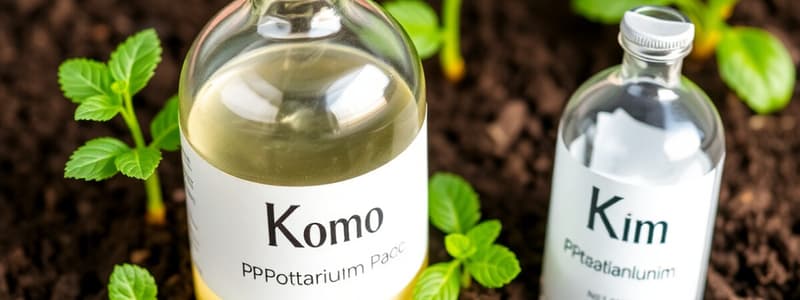Podcast
Questions and Answers
Flashcards are hidden until you start studying
Study Notes
Introduction
- Soil containing Feldspar minerals can have up to 20,000 ppm of potassium, but usually much less is available to plants.
- Potassium fertilizer application may be needed for most soils.
- Potassium is extracted from air-dried soil by shaking with a 0.1M CaCl solution for 30 minutes.
- This process effectively displaces the potentially available potassium ions.
Objective
- Determine plant-available potassium in soils.
Method
- Sample preparation:
- Weigh 2g of air-dried, sieved soil into a 50 ml polyethylene tube.
- Add 20 ml of 0.1M CaCl solution.
- Shake for 30 minutes and allow to stand for a few minutes.
- Filter the supernatant liquid through a dry Whatman No. 2 filter paper.
- Flame Photometer:
- Set the Flame Photometer to "100" using a 100 ppm potassium solution.
- Read the soil extract (and CaCl blank) by aspirating the solution, diluting as necessary in CaCl acid solution.
- Calculate the potassium concentration while considering dilution factors.
- Potassium Standard Dilutions:
- Prepare standard dilutions of potassium for calibration purposes.
- Calculation:
- Use the following formula to convert results to mg/kg of soil: Concentration of P (mg/L) x Volume of Extractant (L) / Weight of Soil (kg)
Potassium Status
- Potassium status categorization is based on soil concentration (mg/kg):
- Very Low: 0-60 mg/kg
- Low: 61-120 mg/kg
- Moderate: 121-241 mg/kg
- High: 241-400 mg/kg
- Very High: > 401 mg/kg
Measuring Potassium in Soils
- Soils can contain a significant amount of potassium (K), but only a small portion is readily available to plants.
- Potassium is extracted from soil samples using a 0.1M calcium chloride (CaCl) solution, which effectively displaces the available potassium ions.
- The extraction process involves shaking a weighed soil sample with CaCl solution for 30 minutes.
- The supernatant liquid is then filtered, and the concentration of potassium in the extract is measured using a flame photometer.
- The concentration of potassium in the extract is then used to calculate the total potassium content in the soil using a specific formula.
- Soil potassium levels are classified into categories: very low, low, moderate, high, and very high, based on their concentration (mg/kg).
- These levels are used to assess the potassium status of the soil and indicate the amount of potassium fertilizer that may be needed for optimal plant growth.
Potassium in Soil
- Soils with Feldspar minerals can contain up to 20,000 ppm of potassium, but this is not always available to plants.
- Potassium fertilizer is often needed to support plant growth.
- A 0.1M CaCl solution is used to extract potassium from air-dried soil samples.
- The extraction process involves shaking the soil with the CaCl solution for 30 minutes, which displaces potentially available potassium ions.
- The supernatant liquid is filtered through a Whatman No. 2 filter paper.
- A Flame Photometer is used to measure potassium concentration, calibrated using a 100 ppm potassium solution.
- Dilution factors are considered when calculating potassium concentration.
- To convert results to mg/kg soil, use the following formula: [Concentration of K in extract (mg/L) * Volume of extractant (L)] / (weight of soil (kg)).
- Potassium status is classified as follows:
- Very low: 0-60 mg/kg
- Low: 61-120 mg/kg
- Moderate: 121-241 mg/kg
- High: 241-400 mg/kg
- Very high: > 401 mg/kg
Studying That Suits You
Use AI to generate personalized quizzes and flashcards to suit your learning preferences.




